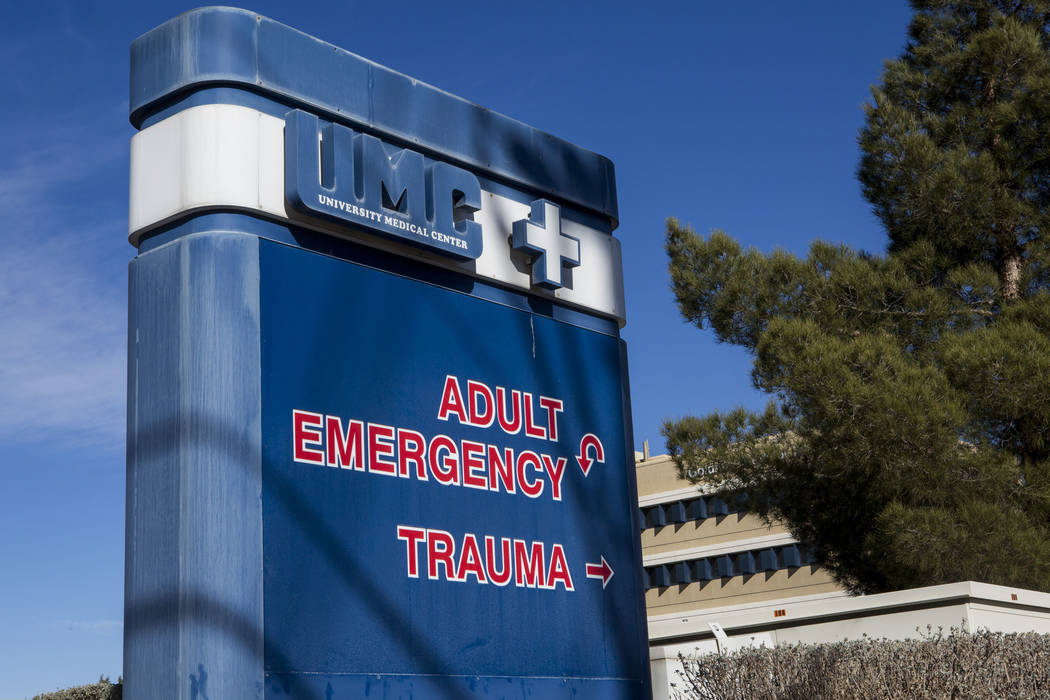Cost of ER visits in Nevada rising quickly, report says

It’s no secret: An emergency room visit for a heart attack or broken leg costs a pretty penny.
But if you get injured or ill in Nevada, you will pay the second-highest price in the nation just to step through the ER doors.
The cost of an emergency department visit in the Silver State, not counting the services actually rendered once you’re admitted, is rising at the fastest rate in the country, according to a report published Wednesday by the Health Care Cost Institute. The average price per claim in Nevada was $1,281 in 2016, trailing only No. 1 California by $7.
Researchers used coding data for employer-sponsored plans from three insurance groups — United Healthcare, Aetna and Humana — to track annual changes in the cost and patient spending related to ER visits. From 2009 through 2016, the latest year for which data was available, the price of an emergency department visit increased 147 percent in Nevada.
It rose 98 percent nationwide in the same time period, the report showed.
Reasons unclear
Why the hospitals are billing insurers for an increasing number of high-severity cases is unclear, experts say.
It could be that Nevadans today are sicker than they were a decade ago, said Chris Cochran, chair of the heath care administration department at UNLV.
Or it could be that Nevada’s ERs are looking to offset the costs incurred by an increasing number of Medicaid patients, Cochran said. A 2014 expansion of the federal program in the state doubled the number of Medicaid patients to more than 600,000, but state health care providers receive one of the lowest reimbursement rates in the nation.
John Hargraves, a senior researcher with the Health Care Cost Institute, a nonpartisan nonprofit devoted to independent research on the causes of rising U.S. health-care spending, said the rapid increase in Nevada may spring from hospitals coding patients as high-severity cases as soon as they walk through the door. That process is known as “upcoding” — or marking patients’ conditions as more severe than they actually are — in order to increase the chances of obtaining a higher reimbursement from private insurers.
“Usually how it works in the ER setting is if the patient appears … because of an emergency, they do a quick assessment of their condition and that is what is going to determine the severity level,” Hargraves said. “And we do see a surprising increase in the severity,” particularly in Nevada.
Bill Welch, president of the Nevada Hospital Association, denied that the industry group’s members engage in the practice of upcoding, noting that it would be considered fraudulent. He blamed the low level of reimbursement of Medicaid costs and the use of ERs as primary care services given Nevada’s doctor shortage.
“The ER is the most costly charge center for any hospital, and the reason for that is because the ER has to be the most equipped, staffed and supplied for any emergency that presents,” he said. “Just like any industry … that sells a product or a service, they do a cost analysis and they say, ‘What does it cost to produce or provide a service?’ And so they try to recoup the cost anytime a service is used.”
Patients often not immediately hit
Patients with insurance may not feel the impact of a higher emergency room facility fee directly because their co-pay and deductible often remain the same while the rest of the bill is covered by the insurer, Hargraves said.
Instead they see an increase in premiums and deductibles over the long term as insurers move to offset rising costs, he said.
“There’s sort of a lack of transparency. Patients don’t understand the system until they get the charge,” Hargraves said, adding that even then, a bill usually doesn’t provide a detailed breakdown of an ER visit. “Over time, it really does start to become more and more a burden on patients.”
Cochran said to get to the bottom of Nevada’s sharply rising emergency room costs, private insurers have to press hospitals about their coding practices.
“If we see that this is a trend, then we have to ask the question, ‘Why would there be high-severity codes?’ ” he said. “Is it because they can get away with it, or is it because we’ve got sicker people?”
But Welch, the head of the hospital association, said the report shows that without higher Medicaid reimbursement rates and a larger primary care workforce, steep prices for emergency care in Nevada will only continue to rise.
“To me, the report is alarming, without question, but it reinforces the concerns we’ve been trying to communicate for some time,” he said.
Contact Jessie Bekker at jbekker@reviewjournal.com or 702-380-4563. Follow @jessiebekks on Twitter.